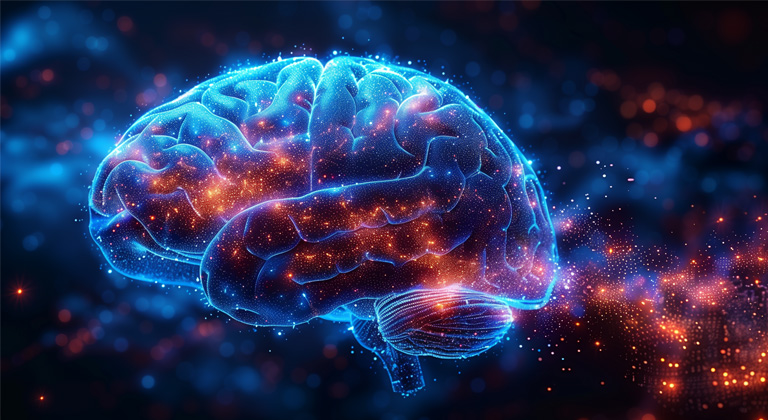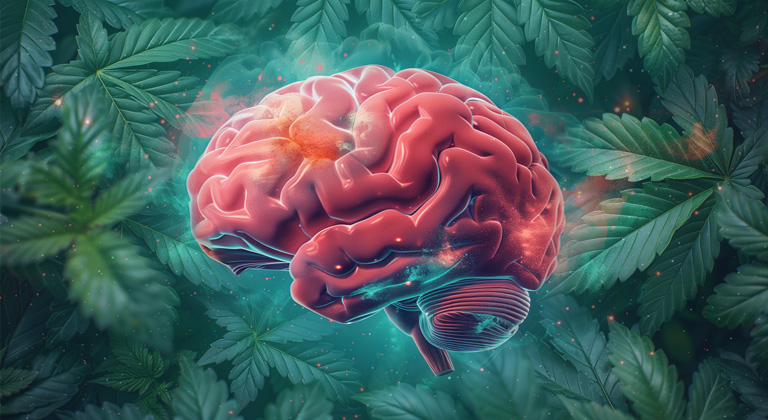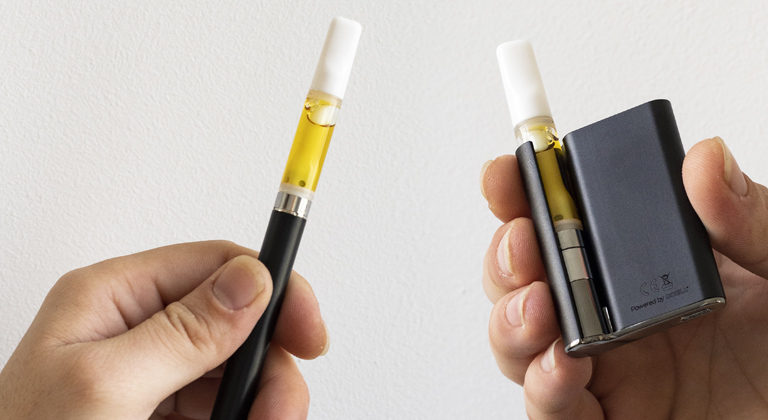Thanks to the gradual legalization of medical cannabis in recent years, there has been a growth in scientific studies regarding its therapeutic potential.
As these studies arise, we learn more about the different functions of the components of cannabis: cannabinoids like THC or CBD; terpenes like limonene or linalool; and how they interact with each other.
Terpenes Enhance the Effects of THC in the Brain
A recent study (8), published in June 2023, aimed to shed light on the debate about the potential of terpenes to increase the effectiveness of cannabinoids. To do so, scientists analyzed the results of activating the CB1 receptors of the endocannabinoid system in the brain using different formulas:
- Only terpenes (16 of the terpenes found in the composition of cannabis).
- Isolated THC.
- THC combined with terpenes.
The results of this investigation revealed that isolated terpenes can activate these receptors, although in a milder way than THC.
However, by combining some terpenes with THC, it was observed that the activation of these receptors was significantly increased, much more so than with isolated THC.
A noteworthy finding was that this higher activation occurred with terpene/THC ratios similar to those seen naturally in the cannabis plant, where terpenes are found in low concentrations.
These results suggest that the combination of terpenes and THC achieves greater effects than isolated compounds; meaning that they enhance each other. Therefore, this supports the theory that some terpenes might modify the interaction of THC in the brain.
Another significant finding of this study is that the activation of the CB1 receptors (in synergy with THC) occurred only with some (and not all) of the cannabis terpenes used, many of which are NOT part of the main terpenes found in larger amounts in the plant.
Therefore, this study suggests that using a full spectrum composition (extracted from the cannabis plant with its corresponding terpene profile) might not necessarily be advantageous in all cases.
According to this research, cannabinoid-based medications should be administered using the most suitable terpenes, and aiming for the highest activation of the receptors involved in the specific condition being treated.
In this regard, the conclusion is that developing cannabis strains that are rich in specific terpenes is a feasible option, but it requires a substantial amount of time and effort.
In contrast, enriching cannabis extracts with selected terpene profiles, whether they come from cannabis or from other plants, is much easier and can be applied using the right dosage and standardization system for cannabis medications.
In conclusion, the study suggests that the use of terpenes could allow for a reduced THC dosage in some cases, thereby minimizing the side effects of this cannabinoid. It could also be a great solution for those patients who have developed a tolerance to THC, by increasing or adding the terpene dosage without having to increase the dosage of this cannabinoid (thus avoiding side effects and its associated psychoactivity).
This would be especially important when adjusting treatments to more sensitive population segments, such as children and the elderly.
The use of selected terpenes could enable the adjustment of the composition to each patient’s needs. It could also allow for changes that might occur in the case of chronic treatments; for instance, between medications taken during the day and those taken to help with sleep.
CBD and Terpenes for Cognitive Enhancement
There are multiple scientific studies on the properties of CBD for the treatment of neurodegenerative diseases (such as Alzheimer’s, Huntington, and Parkinson’s); neuro-inflammatory disorders (like sepsis-induced encephalopathy); and neurological disorders (such as ischaemic brain injury).
In a review of these studies (11), it was concluded that empirical evidence indicates that the entourage effect seems to work better in these cases. This means that, although scientific evidence shows that isolated CBD is a highly effective and safe compound for treating cognitive impairment, it provides a greater effect when administered with other plant compounds.
This scientific review suggests that the benefits of CBD for brain health and cognition could be enhanced with terpenes such as linalool, pinene, and caryophyllene, flavonoids, and anthocyanin (a group of plant pigments that bestow some cannabis plants with bluish, reddish, purplish, and black colours).
The entourage effect would appear to be more suitable for treating the conditions mentioned above.
Doses and amounts of each compound should be properly studied for each treatment. Therefore, more research is currently needed to determine the optimal prescription for treating specific diseases: this would include dosage, administration route, long-term clinical efficacy, safety, and side effects.
Please remember that, while terpenes do not produce any psychoactive effects, they have properties of their own (antifungal, anti-inflammatory or anxiolytic, among others), with each of them producing specific effects in this regard.

Direct to the Brain: The Ability of Terpenes to Cross the Blood-Brain Barrier
The blood-brain barrier (BBB) is a protective structure that regulates the passage of substances between the blood and the brain.
You could imagine it as a kind of filter designed to protect the brain tissue from harmful substances. The BBB allows the passage of essential nutrients whilst simultaneously blocking pathogens, toxins, etc.
The problem arises when certain therapeutic substances are administered but fail to fully cross the BBB, meaning that their effect is reduced.
Several studies (1, 2, 3, 4, 5) state that, given the small and liposoluble nature of certain terpenes, they can transfer through the nasal mucosa during inhalation, as well as through the skin after topical application, and can thereby enter the bloodstream and cross the blood-brain barrier more easily.
One of these studies (4) states that this ability could help enhance cognitive performance (thanks to certain properties of specific terpenes), and be a possible tool in the treatment of neurodegenerative diseases like Alzheimer’s.
In another study (5), the protective capacity of terpenes on the degradation of the BBB itself was reviewed. This study states that terpenes might help modulate the signalling cascades associated with deterioration of the blood-brain barrier, and thereby limit the progression of neurological disorders.
Both studies suggest that terpenes have significant potential in the medical field, thanks to their ability to cross the blood-brain barrier (BBB) and to provide protective or therapeutic effects on the brain. However, further research is still needed to gain a deeper understanding of these mechanisms and how they can be effectively applied to medical treatments.
Can terpenes promote the penetration of cannabinoids into the brain?
While the ability of terpenes to cross the blood-brain barrier has been scientifically proven, the million-dollar question is whether these molecules also increase their permeability for other compounds.
Evidence of the effective properties of cannabinoids for medicinal use has accumulated over recent decades, especially for their abilities to treat pain and inflammation. However, one significant challenge for the pharmaceutical and therapeutic sector (when creating cannabinoid-based medical products) is their absorption potential.
This can lead to inconsistent doses and erratic absorption levels, caused by features associated with cannabinoids, including their low solubility and bioavailability depending on the administration route. The need to incorporate systems that increase absorption levels is imperative.
Therefore, the main focus is on the ability of terpenes to increase the permeability of the blood-brain barrier, thereby allowing a higher absorption of cannabinoids.
The empirical experience of both patients and recreational users supports an increased effect of cannabinoids when administered combined with terpenes. As mentioned earlier, this phenomenon is commonly known as the entourage effect.
However, further research is needed to understand the mechanisms through which this happens.
In a review of related scientific studies (6), the ability of myrcene to enhance the innate properties of cannabinoids as analgesics (i.e. their ability to reduce pain) was studied.
Seemingly, myrcene could enhance the analgesic effects of cannabinoids by increasing BBB permeability, leading to an increase in the transportation of cannabinoids to the brain. However, it is clear that further research is needed on this specific topic to gain more certainty about these mechanisms.
Another study (7) showed that myrcene, one of the main terpenes in cannabis (and present in most strains), contributes to the transdermal (i.e. through the skin) absorption of other substances.
The study also found that this terpene is effective in itself as an analgesic, meaning that it helps relieve pain.
Interestingly, the analgesic effect of myrcene is halted when naloxone is applied (this is a medication that reverses the effects of opioids). This suggests that myrcene may act in a similar way to opioids in our body.
However, myrcene itself does NOT directly bind to opioid receptors (like opiate-based medicines do), but its pain-reducing effect would be based on the stimulation of our body’s naturally produced endogenous opioids.

Terpenes mimic the effects of cannabinoids and enhance their action
Another study (9), published in April 2021 in the acclaimed scientific journal Nature, studied the canabimimetic effects of terpenes and their ability to amplify the effects of cannabinoids.
The term canabimimetic refers to mimicking the effects of cannabinoids, either in the central nervous system or other body systems. This research was carried out in vitro and in animals, and used terpenes in combination with WIN55,212, a compound that mimics the action of cannabinoids.
The researchers observed that terpenes like humulene, geraniol, linalool, and pinene, induced effects in mice similar to those produced by cannabinoids, indicating the ability of these aromatic molecules to mimic their activity.
To support this theory, the researchers used substances to block the effects of cannabinoids. Upon doing so, the effects of the terpenes on the subjects stopped.
In the second phase of the study, the researchers combined the terpenes with WIN55,212 (the compound that mimics cannabinoid action), and the effects on the mice’s behavior were significantly enhanced.
In the lab experiments, it was observed that the studied terpenes activated the endocannabinoid system receptors located in the brain. These findings suggest that terpenes not only have their own effects, which can mimic cannabinoids in some cases, but may also be useful in enhancing the therapeutic benefits of cannabinoid treatments.
Conclusions on the interaction of terpenes and cannabinoids
It’s exciting to witness the vital role that terpenes may play in the future of medical cannabis and the advancement of science in this direction. Beyond being the components that provide aroma and flavor to the cannabis plant, terpenes emerge as a powerful tool to enhance the properties of cannabinoids, opening up new paths for more effective and personalized treatments.
Through a deeper understanding of the mechanisms by which this happens, we could be closer than ever to unlocking a new paradigm for the treatment of pain, inflammation, and other conditions, while minimizing the associated adverse effects of cannabinoids. These scientific studies not only support the validity of the ‘entourage effect’ but highlight the need for further research on terpenes and their synergy with cannabinoids to fully leverage the therapeutic potential of cannabis.
-
- Zhang, Q. et al. “Borneol, a novel agent that improves central nervous system drug delivery by enhancing blood–brain barrier permeability”. Drug Delivery. 2017; 24(1): 1037-1044 [Times cited = 20, Journal impact factor = 4.843]
- Yu, B. et al. “The mechanism of the opening of the blood–brain barrier by borneol: A pharmacodynamics and pharmacokinetics combination study”. J Ethnopharmacology. 2013; 150(3): 1096–1108 [Times cited = 67, Journal impact factor = 3.115]
- Wu, T., et a. “The Role and Mechanism of Borneol to Open the Blood-Brain Barrier”. Integr Cancer Ther. 2018; 17(3): 806–812 [Times cited = 1, Journal impact factor = 2.675]
- Agatonovic-Kustrin S, Kustrin E, Morton DW. Essential oils and functional herbs for healthy aging. Neural Regen Res. 2019 Mar;14(3):441-445. doi: 10.4103/1673-5374.245467. PMID: 30539810; PMCID: PMC6334595.
- Kam A, Li KM, Razmovski-Naumovski V, Nammi S, Chan K, Li Y, Li GQ. The protective effects of natural products on blood-brain barrier breakdown. Curr Med Chem. 2012;19(12):1830-45. doi: 10.2174/092986712800099794. PMID: 22376038.
- REVIEW article. Front. Nutr., 19 July 2021. Sec. Nutrition and Metabolism. Volume 8 – 2021 | https://doi.org/10.3389/fnut.2021.699666. Myrcene—What Are the Potential Health Benefits of This Flavouring and Aroma Agent?
- Cooperative Interaction of Monoterpenes and Phenylpropanoids on the in vitro Human Skin Permeation of Complex Composed Essential Oils Sonja Schmitt1 , Ulrich F. Schaefer2 , Leonhard Doebler3 , Jürgen Reichling1 1Institute of Pharmacy and Molecular Biotechnology, Department of Biology, University of Heidelberg, Heidelberg, Germany 2Department of Biopharmaceutics and Pharmaceutical Technology, Saarland University, Saarbruecken, Germany. 3Department of Plastic, Aesthetic and Reconstructive Surgery, Atos Praxisklinik, Heidelberg, Germany Raz N, Eyal AM, Zeitouni DB, Hen-Shoval D, Davidson EM, Danieli A, Tauber M, Ben-Chaim Y.
- Selected cannabis terpenes synergize with THC to produce increased CB1 receptor activation. Biochem Pharmacol. 2023 Jun;212:115548. doi: 10.1016/j.bcp.2023.115548. Epub 2023 Apr 19. PMID: 37084981.
- LaVigne JE, Hecksel R, Keresztes A, Streicher JM. Cannabis sativa terpenes are cannabimimetic and selectively enhance cannabinoid activity. Sci Rep. 2021 Apr 15;11(1):8232. doi: 10.1038/s41598-021-87740-8. PMID: 33859287; PMCID: PMC8050080.
- Bicker J, Fortuna A, Alves G, Falcão A. Nose-to-brain Delivery of Natural Compounds for the Treatment of Central Nervous System Disorders. Curr Pharm Des. 2020;26(5):594-619. doi: 10.2174/1381612826666200115101544. PMID: 31939728.
- WESTON-GREEN, Katrina. The united chemicals of cannabis: beneficial effects of cannabis phytochemicals on the brain and cognition. En Recent Advances in Cannabinoid Research. IntechOpen, 2018.









